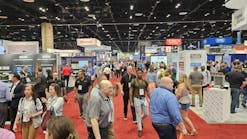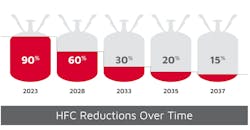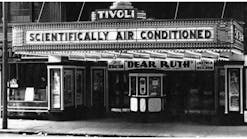Amid the current push to “go green” by building high-efficiency, environmentally sound, sustainable HVAC systems, heat pumps — particularly those that use the earth's geothermal energy to serve as a heat sink and source — are generating a lot of buzz. Ground-source heat-pump (GSHP) systems operate like every other HVAC system: They move energy from one place to another. Although that sounds simple, HVAC engineers and designers owe their livelihoods to the complexities.
In most cases, GSHP systems are a suitable green solution, providing sustainability and energy efficiency. They reduce the amount of heat rejected into the atmosphere during cooling periods and decrease the amount of heating energy required from local utility companies — a win-win situation. However, popularity sometimes can lead to improper applications. This article will discuss various elements important to sound design and installation.
Because this article can only scratch the surface of the myriad conditions engineers need to consider before installing a GSHP system, references are included for further study. Additionally, for the purposes of this article, the term “GSHP” refers to a variety of heat-pump systems that use geothermal energy but utilize a variety of technologies. For brevity, the article will focus on ground-coupled systems.
BACKGROUND
For the last five decades, designers have used water-source heat pumps in commercial buildings successfully. However, geothermal pumps are a more recent application. During the oil embargo of the 1970s, builders became more concerned with alternative HVAC solutions, such as air-to-air heat pumps. While the heat pumps provided excellent efficiency at temperatures above 15°F to 20°F, defrost cycles resulted in ice formations during subfreezing temperatures. Below 15°F, their efficiency was equivalent to or less than that of resistance-heat equipment.
Alternately, geothermal energy proved to be an efficient and popular solution because ground temperatures remain constant, making it easier to extract heat during winter and cool water in summer. Additionally, GSHPs are equipped for small temperature-control zones and varying weather conditions. They require minimal chemical treatment and little service once installed.
GSHPs were developed primarily for use in the residential and light-commercial marketplace, but engineers dealing with energy-efficiency concerns and “green” objectives soon adapted them for larger buildings. GSHPs began moving into suburban markets and currently are in the high-density environs of major cities. Installations have moved from regional locations to national levels. Now, not only are GSHPs in larger buildings, but in applications across more climatic zones.
Designers have been quick to accept GSHPs, but as applications expand, so do design concerns. To that end, designers are experiencing a new challenge: geology. With GSHPs, HVAC engineers have had to move past the traditional 5-ft-from-the-building-line mandate into a world of drilling and bore-hole heat exchangers. These have become key elements of the geothermal-heating concept.
Currently, pure GSHP systems are being used in larger buildings successfully. However, there are limitations, meaning hybrid solutions sometimes are required. A pure GSHP system is bound by the amount of land available for the ground loop — the portion of the system that connects with the ground for heat transfer — and the viability of creating a sufficient bore field. However, hybrid systems also can be used in larger buildings successfully. Closed-circuit fluid coolers (cooling towers) can meet the heat-rejection needs of larger cooling-load applications, while, in a similar fashion, a heat-driven application may supplement capacity with a boiler or solar array.
GSHP systems typically are not installed in zones with design temperatures well below 0°F and zones that experience more than 7,000 degree-days. Cooling requirements can be met by lowering ground temperatures with a hybrid GSHP system that includes booster water heaters to optimize heat-pump efficiencies and give startup capacity after night setbacks.
Although GSHPs can be attractive systems, they often require more study than some designers and engineers realize. Fortunately, the American Society of Heating, Refrigerating and Air-Conditioning Engineers (ASHRAE) has published quite a bit of technical literature on the topic. No one should design a GSHP system without a thorough review of ASHRAE's materials. Each situation can vary greatly, and there are no simple approaches that can replace quality design.
SYSTEM BREAKDOWN
Let's look at the components of a GSHP system:
- Bore field
The bore field is the “ground” component of ground-source heat pumps. Essentially, the building draws energy from the building's interface with the earth. The bore field has dual functions in the HVAC process: It serves as the heat-rejection device (sink) and replaces boilers as a heat source.
There are no shortcuts in bore-field design. First, geological conditions must be studied. Data and maps can be accessed from the American Association of State Geologists and the United States Geological Survey, which provide information and links to many resources. Next, engineers must consider geological conditions, calculating field size and boring depth. Holes need adequate space to avoid impacting one another; thus, hole depth must be determined properly. Grout and sealant must be selected and installed carefully. Most importantly, an experienced driller should be selected, field testing should be conducted early, and the thermal performance of bores should be validated.
GSHP manufacturers have indicated that designers are specifying lower water temperatures because they want to design for adequate heating during extreme conditions. GSHP capacities can drop or rise greatly with temperature variances. As the only heat source, a GSHP must perform without limitations. Designers sometimes solve this issue by adding boilers to raise ground-water temperatures to meet a building's needs. Inclusion of such booster heating can account for unknown ground-performance changes, weather extremes, changes in building function, and operational errors.
- Piping system
Quite a bit of engineering is required to provide a quality piping system. Improper sizing can result in more energy being used by water pumps than heat pumps. Because a GSHP system can be considered a group of unitary systems that depend on water and electricity to operate, reliable water flow is as critical as electricity. A piping system must be analyzed carefully and perform according to specifications. Prudent design is recommended.
- Heat pumps
Heat pumps are the heart of every GSHP system. With smaller capacities, they are efficient and can be easily maintained by most HVAC technicians. However, these units function as single-zone terminal air-conditioning units. While straightforward, they are susceptible to significant shifts in capacity, with water temperatures that do not meet design conditions.
- Controls
“Less and simple” is better than “more and complex.” Because heat pumps are simple, they perform better with uncomplicated controls.
- Ventilation
When larger systems are designed, ventilation approaches can vary extensively. In more humid climates, GSHPs sometimes are used to provide chilled water to dedicated-outside-air systems (DOAS). This approach avoids problems, such as frosted coils, that occur with direct-expansion coils in humid climates and gives greater flexibility in sensible- and latent-cooling situations.
Proper design conditions must be created for 100-percent-outside-air units. It is worth noting that ASHRAE's recommended cooling condition of 1 percent commonly is exceeded throughout the eastern United States, and engineers must consider similar types of abnormal design situations.
A weather system with dry-bulb temperatures in the mid-90s and wet-bulb temperatures in the 80s recently passed through the Midwest. The front affected Missouri, Kentucky, Illinois, Indiana, and southern Ohio for more than three days. Such conditions can cause a DOAS to act as a humidity injector for a building. Dehumidification controls become a necessity and the situation typically is not corrected immediately after installation.
HYBRID SOLUTIONS
While a pure GSHP system can be a goal, hybrid solutions also should be considered, especially for less-than-ideal weather conditions. For a heating project, a hybrid solution might be used because ground temperatures do not always provide water warm enough to satisfy extreme heating requirements. In such cases, a design incorporating a water heater in the loop after it enters the building can provide a heating boost, resulting in sufficient heat without lowering system efficiency throughout most of the year. Additionally, this approach can limit the cost of drilling more or deeper wells for ground-heat transfer. Because GSHP system designs require economic analysis, a designer should model a number of schemes for loop sizes, depths, pumping efficiencies, equipment sizes, run times, etc.
For cooling projects, cooling boosters commonly are incorporated into designs of hybrid systems. Open cooling towers are undesirable because of the need for makeup water, chemical treatment, and associated extra maintenance. However, it is popular to use closed-circuit evaporative coolers, which can provide booster cooling to a water system while a closed-piping arrangement is maintained. Such supplemental-cooler concepts are similar to the previously mentioned heating model. Supplemental cooling equipment may be needed only for extremes, but designers can choose to have the equipment operate during certain conditions because it can provide higher efficiencies within GSHP units.
With current software, engineers can increase a building's efficiency by incorporating online interactive control of systems that previously ran relatively wild without regard for operating costs. Hybrid systems should be considered in almost all preliminary design analyses. They can reduce first and operating costs while giving a building greater capacity and flexibility.
CONCLUSION
GSHPs are a relatively new technology that can be beneficial to building owners with respect to initial and operating costs and indoor space conditions. The challenge is for engineers to commit themselves to learning the technology, resulting in proper application.
Well-engineered buildings cannot be created from a recipe. However, keys to a successful GSHP project include:
- Knowing geological conditions.
- Evaluating bore-field size, depth, and spacing.
- Requiring an experienced driller.
- Making and reviewing test wells before final work is done.
- Preparing a cost analysis of the bore field.
- Knowing each zone's heating and cooling loads.
- Fully analyzing all possible pumping solutions.
- Evaluating control options.
- Remembering that GSHPs are unitary systems.
- Controlling humidity.
- Ensuring systems are balanced.
RESOURCES
ASHRAE. (1995). Commercial ground-source heat pump systems. Atlanta: American Society of Heating, Refrigerating and Air-Conditioning Engineers.
Sachs, H. (2002). Geology and drilling methods for ground-source heat pumps installations: An introduction for engineers. Atlanta: American Society of Heating, Refrigerating and Air-Conditioning Engineers.
Kavanaugh, S., Rafferty, K., & Geshwiler, M. (1997). Ground-source heat pumps: Design of geothermal systems for commercial and institutional buildings. Atlanta: American Society of Heating, Refrigerating and Air-Conditioning Engineers.
Fisher, D., Rees, S., Padhmanabhan, S., & Murugappan, A. (2006). Implementation and validation of ground-source heat pump system models in an integrated building and system simulation environment. HVAC&R Research Journal, 12, 693-710.
ASHRAE. (2007). HVAC applications handbook. Atlanta: American Society of Heating, Refrigerating and Air-Conditioning Engineers.
ASHRAE. (2008). ASHRAE handbook — HVAC systems and equipment. Atlanta: American Society of Heating, Refrigerating and Air-Conditioning Engineers.
ASHRAE. (2009). ASHRAE handbook — fundamentals. Atlanta: American Society of Heating, Refrigerating and Air-Conditioning Engineers.
Mumma, S.A. (2009). 30% surplus OA: Does it use more energy. ASHRAE Journal, 6, 24-36.
Anthony B. McGuire founded McGuire Engineers in 1986 after working in engineering firms in Chicago, Indianapolis, Boston, and New York. As chairman of the company, he is involved in the consultation, design, and construction of mechanical and electrical systems around the world. A registered engineer in 21 states, he has received numerous honors from professional engineering associations. He serves as an advisor to the Chicago Building Department and the Chicago Building Owners and Managers Association.








